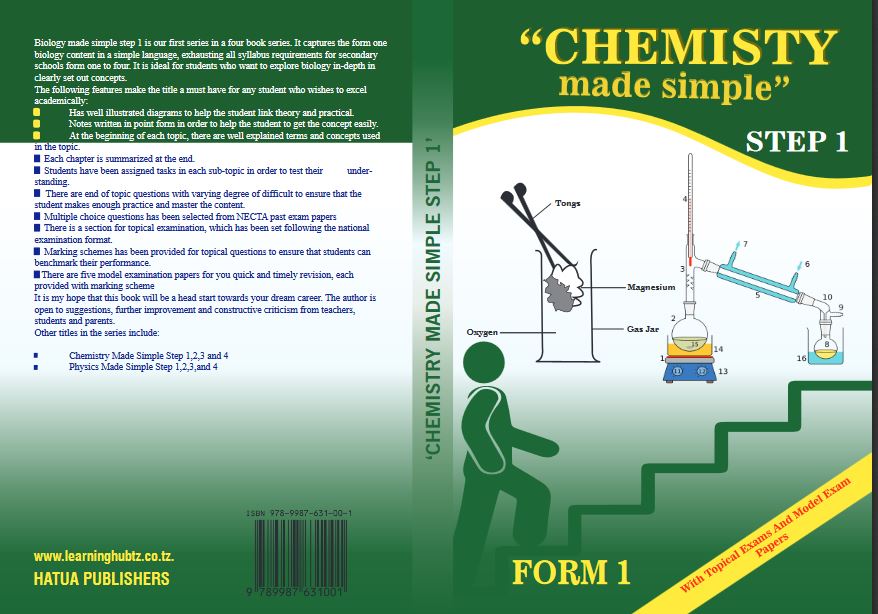
FORM THREE HISTORY EXAM SERIES 237
FORM THREE HISTORY EXAM SERIES 237
THE PRESIDENT’S OFFICE
REGIONAL ADMINISTRATION AND LOCAL GOVERNMENT
FORM THREE ANNUAL EXAMINATION
HISTORY
TIME: 3 HOURS NOVEMBER 2024
Instructions
1. This paper consists of three sections A, B and C with a total of eleven (11) questions.
2. Answer all questions in sections A and B and two (2) questions from section C.
3. Section A carries sixteen (16) marks, section B carries fifty four (54) marks and section C carries thirty (30) marks.
4. Cellular phone and any unauthorized materials are not allowed in the examination room.
5. All writings should be in blue or black ink while drawings should be in pencil.
6. Write your Examination Number on every page of your answer booklet(s)
SECTION A (16 Marks)
Answer all questions in this section
1. For each of the items (i)- (x), choose the most correct answer from among the given alternatives and write its letter beside the item number in the answer booklet provided.
(i) Dr. Kisopa wrote a report about the bones and skulls of early human beings which were obtained at Olduvai Gorge. Which way of historical information helped him to prepare his report?
A. Oral traditions
B. Archives
C. Anthropology
D. Historical site
E. Archeology
(ii) Udeze lived in Africa many centuries ago, he lived in the condition which man ate raw food, used simple stone tools and their bodies were covered with hair. At which age did Udeze live?
A. Late Stone Age
B. Early Stone Age
C. Middle Stone Age
D. Mesolithic Stone Age
E. New Stone Age
(iii) Our grandfather told us that Uvinza is one among the important places in the history of Tanzania. What do you think Uvinza was famous for during the pre-colonial era?
A. Obtaining salt from different reeds
B. Obtaining salt by boiling and evaporation method
C. Obtaining salt directly from salty rocks
D. Obtaining salt by sieving and boiling water to get salt crystals
E. Obtaining salt by exploiting inner resources
(iv) Nakuchema was a Makonde boy who married a girl called Shimbanga. After marriage ceremony they went to live to Shimbanga’s family. Relate this with one of the following types of societies.
A. Patrilineal society
B. Age-set society
C. Ntemiship society
D. Matrilineal society
E. Centralized society
(v) Before colonialism in Africa, Mkuro’s grandfather was owning large farms which he rent to the poor people who had to pay him. Which identity could be referred to Mkuro’s grandfather?
A. Feudal lord
B. Feudalist
C. Land renter
D. Tenant
E. Peasant
(vi) The following were the characteristics of colonial education except
A. It based on rudimentary curriculum
B. It segregated the Africans
C. Focused on literacy and numeracy
D. It reflected the interest of Africans
E. It was provided to few people
(vii) The Coast of East Africa was controlled by the Portuguese for almost two centuries. This control ended after the collapse of Fort Jesus in 1698. Identify one reason from the following that caused the end of that control:
A. The introduction of Christianity
B. The coming of Bartholomew Diaz around the Cape
C. Emergence of Dutch around East Africa
D. Attacks from the Zimba warriors
E. Abolition of slave trade along the Coast
(viii) Maulid’s father participated in pre-colonial trade here in Africa where he exchanged minerals with clothes from his fellow trader from Britain. Point down the stage of capitalism in which that exchange took place.
A. Contemporary capitalism
B. Competitive capitalism
C. Mercantile capitalism
D. Industrial capitalism
E. Monopoly capitalism
(ix) The French colonialists spent their time and resources to make sure that Africans behave and act as French people. Why did they use that kind of policy?
A. To educate Africans about human rights
B. To encourage racial segregation
C. To prepare puppet class of African leaders
D. To encourage Africans to accept the rule of law
E. To reduce the cost of administration
(x) Suzi’s father is a chairperson of ruling political party X and Khadija’s father is a chairperson of opposition political party Y. These parties make our country a multiparty nation. Why do you think this system was considered better than a single party system?
A. It promotes dictatorship
B. It promotes democracy
C. It promotes national unity
D. It promotes peace and harmony
E. It promotes African traditions
2. Match the explanations of African leaders who resisted on colonial occupation in List A with their corresponding African traditional leaders in List B by writing the letter of the correct response beside the item number in the answer booklet provided.
| LIST A | LIST B |
| (i) He was assassinated by British in 1905 and his death resulted to the outbreak of Nandi resistance (ii) He was captured by British on April 9, 1899 together with Kabaka Mwanga II of Buganda and exiled to Seychelles for 24 years (iii) The second son of Mkasiwa who blew himself and his wife with a gunpowder magazine escaping to be captured by Germans (iv) His resistance against French was long lasting resistance in the history of West Africa (v) He resisted against Germany invasion in Namibia and died in exile on March 14, 1923 (vi) He led the African resistance in Southern Tanganyika, he was captured by Germans and hanged at Mango tree
|
A. Koitalel Arap Samoei B. Samori Toure C. Mzilikazi D. Isike E. Samuel Maherero F. Mkwawa G. Hassan Makunganya H. Omukama Kabarega I. Abushiri bin Salimu
|
SECTION B (54 Marks)
Answer all questions in this section
3. Briefly answer the following questions;
(i) Why Kwame Nkurumah is regarded as an important prominent figure during the liberation struggle of African continent? Give three reasons.
(ii) Explain with vivid examples the three forms of nationalism used in Tanganyika, Zanzibar and Angola.
(iii) Though U.S.A was the leader of capitalist block, she engaged herself in the process of supporting Africans to abandon colonialism. What was the hidden agenda? Provide three points.
4. Arrange the following historical event in a chronological order by writing number 1 to 6
i. Before 1800 AD Africa and its interior were not known to the outside world.
ii. The interior of Africa was exposed to European world after the work of the agents of colonialism.
iii. Europeans took interests in African strategic areas with fertile soil, mineral and navigable rivers.
iv. Reports of the existence of snow-capped mountains in the interior of Africa attracted great interest in the continent
v. People like Dr Livingstone, Mungo Park, worked greatly to acknowledge their mother countries about the richness of African continent
vi. By 1880s, many European nations rushed and grabbed parts of African
Continent claiming they were areas of their influence
5. Draw a sketch map of Africa and locate the areas of the following historical events by using roman numbers.
(i) The country where Abubakary Tafawa Balewa was overthrown and assassinated by the military.
(ii) The country where Patrice Lumumba was assassinated by Belgian officers and African puppets.
(iii) The country where Thomas Sankara was overthrown and assassinated on October 15, 1987.
(iv) The country where Anwaar Sadat was assassinated on October 6, 1981.
(v) The country where Tom Mboya was assassinated on July 5, 1969.
6. Kunta Kinte was sold as a slave during the 15th Century slave trade in West Africa. Show how Western societies were affected with this trade. Give three points.
7. Kingazi went to visit Egypt as his holiday vacation. He was told, Egypt during the scramble for Africa took a great attention to European Imperialist countries. As an expert, analyse the potentialities of Egypt. Give any three.
8. Professor Kahigi claimed that “Colonial economy differed from previous types of economies.” Give three points to support his claim.
SECTION C (30 Marks)
Answer only two (2) questions in this section
9. Mr. Mbonani is leaving near your house. His tribe is Ngoni which is found in Songea. Trace any six reasons for the coming of Mr. Mbonani’s tribe to East and Central Africa.
10. The New East African Community is striving to bring sustainable development to it’s member states. As a member of the community, examine six problems which hinder the attainment of the community objectives.
11. After independence, most of African states were struggling to change the colonial nature of education sector. Highlight six changes adopted by African states in this sector.
FORM THREE HISTORY EXAM SERIES 186
FORM THREE HISTORY EXAM SERIES 186
OFFICE OF THE PRESIDENT, REGIONAL ADMINISTRATION AND LOCAL GOVERNMENT
COMPETENCY BASED ASSESSMENT
SECONDARY EXAMINATION SERIES
HISTORY ANNUAL EXAMINATION –2023
FORM THREE
TIME: 3 Hours
INSTRUCTIONS:
- This paper consist of sections A, B and C with a total of eleven (11) questions
- Answer ALL questions in section A and B, and two questions from section C
- Section A carry 16 Marks, section B carry 54 Marks and section C carry 30 Marks
- Write your Examination number or name on every page of your answer sheet(s).
SECTION A (16 Marks)
Answer ALL questions in this section
- For each of the following items (i) – (x), choose the correct answer among the given alternatives and write its letter beside item number
- The missionary who came to East Africa and opened the first missionary center at Rabai in 1846 was
- Dr. David Livingstone
- John Speke
- Richard Burton
- John Ludwing Kraft
- Carl Peter
- After the first world war of 1914-1918 the league of Nations made Tanganyika as
- Mandate territory
- Protectorate territory
- Independent territory
- Trust territory
- British East Africa Empire
- The military alliance which was formed between German, Italy and japan before the second world war was known as
- Berlin-Rome-Tokyo axis
- Triple alliance
- Triple entente
- Berlin-Rome
- Dual alliance
- Assimilation policy in Mozambique was adopted by which European country
- German
- Italy
- Portugal
- Britain
- France
- A form of colonial economy which was practiced in British East Africa was called?
- Settler economy and mixed economy
- Plantation and mixed economy
- Peasant and settler economy
- Settler and Plantation Economy
- Peasant and plantation economy
- Which of the following treaties prohibited the sultan from exporting slaves outside of Africa
- Moresby treaty
- Frère Treaty
- Hermeton treaty
- Bogus Treaty
- Helgoland
- What did the golden stool which was possessed by Asante Empire in West Africa Symbolize?
- Myth of the state
- Unit of state
- Dream of the state
- Decline of state
- Wealth of state
- The colonialist decided to use different methods to establish colonialism in Africa since it was not easy for Africans to accept colonialism. What was the aim of using intimidation as the method of establishing colonialism in Africa?
- To exercise new military fighting weapons
- To demonstrate the European military strength to Africa
- To implant Africa awareness tow arch colonialism
- To stimulate African Army Unity
- To create fear and Suppress Africa solidarity against colonialism
- Colonialists established various forms of Agriculture that involved use of different colonial Africa labour during colonial economy. Which type of colonial Africa labour was used under peasant agriculture?
- Migrant labour
- Family
- Forced labour
- Contract labour
- Permanent labour
- Mtukazi was the daughter of a chief in a certain tribe in East Africa; his family was forced by colonialist to work in certain social services. His father was also forced by colonists to supervise colonial activities. What was the type of administration that was used in area?
- Assimilation policy
- Association policy
- Indirect Rule
- Divide Rule
- Direct Rule
2. Match the items in List a with responses in List B BY WRITING THE LETTER OF THE CORRECT RESPONSE beside the item number in the answer booklet provided
| LIST A | LIST B |
|
|
SECTION B (54 Marks)
Answer all questions in this section
3. Briefly explain the following
- How did interaction between pre-colonial societies result in spread of new Agricultural skills and practices
- Differentiate between local Trade and Regional Trade
- Comment on Association policy as it was used by French in West Africa
- Explain protest and Religious movement
- What do you understand by social organization
4. Arrange the following statements in chronological order by writing number 1 to 6 beside the item number
- This allowed him to devote some of his time on other activities such as craft
- This was marked by spread of agricultural communities in area where there were fertile, arable and reliable rainfall
- By then the iron Age in East Africa had reached advanced stage
- With better and more durable iron tools, mans capacity to produce beyond his immediate subsistence requirement increased
- By about 15th century, village communities had emerged in various parts of East Africa
- The iron Age was a period in which man made and used iron tools
5. Draw a sketch map of Tanzania showing railway line built during the colonial era and show the following railway centres
- Railway from Dar-es Salaam to Kigoma
- Railway from Tabora to Mwanza
- Railway from Tanga to Arusha
- Railway from Tabora to Mpanda
6. Outline six impacts of early contacts in East Africa and outside world
7. The collapse of fort-Jesus in Mombasa in 1698 marked the end of Portuguese rule in East Africa Show six (60 main factor which led to end of Portuguese rule in East Africa
8. British was the first country to industrialize, also was the first European Nation to campaign against slave trade and slavery worldwide. By using this notion, briefly explain why the abolition of slave trade took so long time. (six points)
SECTION C (30 Marks)
Answer two (2) questions in this section
9. Most of Africa states achieved independence but they are still suffering from colonial heritage challenges. Assess six economic, social and political challenges in-herited from colonialist
10. The establishment of colonial rule in Africa was not an easy task European faced several obstacles. By referring from this statement, explain six ways used to establish colonial rule in Africa.
11. How did abolition of slave trade affect the east African countries? Use six points to elaborate.
FORM THREE HISTORY EXAM SERIES 155
FORM THREE HISTORY EXAM SERIES 155
THE PRESIDENT’S OFFICE MINISTRY OF EDUCATION, REGIONAL ADMINISTRATION AND LOCAL GOVERNMENT
COMPETENCY BASED SECONDARY EXAMINATION SERIES
032/1 HISTORYFORM THREE
TIME: 3 HOURS NOVEMBER 2022
INSTRUCTIONS
- This paper consists of section A, B and C with a total of nine (09) questions
- Answer all questions in section A and B and three (03) questions from section C.
- All drawings should be in pencil
- Write your examination number on every page of your answer sheet provided.
SECTION A (20 MARKS)
Answer All questions in this section
- For each of the items (i-xv) choose the correct answer from among the given alternatives and write its letter beside the item number in the answer sheet provided:
- Human activities against nature and production relations are fully understood through the study of:
- Archaeology
- Literature
- History
- Museums
- Archives
- Man started to be skillful and tool maker at the stage of:
- Homo sapiens
- Homo erectus
- Homo habilis
- Modern apes
- Zinjanthropus
- Dr. Robert Moffatworked as a missionary in one of the following stations:
- Salisbury
- Kuruman
- Blantyre
- Maposeni
- Rabai
- The Portuguese conquest of East Africa Coast was led by:
- King Emmanuel
- Ahmed Ibin Majid
- Henry the Navigator
- Vasco Salgado
- Francesco D’ Almeida
- The leader of Chimulenga Uprising of 1896-1897 in Rhodesia were
- Mkwati and Kinjikitile
- Singinyamatish and Lobengula
- Mkwati and Singinyamatish
- Mkwati and Lobengula
- Lobengula and Rumunguru
- Tanzania adopted new economic strategy in 1967 known as:
- Operation feed yourself
- Ujamaa and self reliance
- Humanism
- Common man’s charter
- Independence now
- The core ideas of French Revolution were:
- Slave trade, colonialism and Neo-colonialism
- Market, raw materials and Cheap labour
- Communalism, slavery and feudalism
- Fratenity Liberty and Equality
- Scramble, Partition and Bogus treaties
- Asante was one of the forest states which resisted against the:
- French
- Germans
- Belgians
- Dutch
- British
- Ghana empire broke apart due to the following reasons;
- Attack from almoravids
- Role of trans-saharan trade
- Role of Simanguru
- Attack from Bunyoro
- Coming of europeans
- African countries have tried to bring about real independence through:
- Setting new factories and political instabilities in Africa
- Improving communication systems and military coups
- Expanding Education and Agricultural practices
- Establishing heavy industries and free market economy
- Expanding agricultural production and administering trust territories
- Which of the following societies in West Africa were famous in using copper alloys for making various ornaments?
- Ibo and Yoruba
- Venda and Mashona
- Maganja and Fulani
- Yoruba and Mandika
- Mandika and Ibo
- What is the most supreme organs of United Nations Organization?
- Trusteeship council
- Secretariat
- Security Council
- General Assembly
- International court of Justice
- The period which man was able to make chopping and pebble tools s known as:
- Late Stone Age
- Old Stone Age
- Middle Stone Age
- Iron Age
- Industrial Age
- Which among the following places did people extract salt from salt bearing rocks?
- Uvinza and Taghaza
- Taghaza and Bilma
- Axum and Taghaza
- Meroe and Egypt
- Uvinza and Bilma
- The British colonial rule in East Africa constructed the Uganda railway in order to:
- Attract more Europeans settlers to Kenya
- Compete with the Imperial German East African rule
- Provide cheap means of Transport for the East Africa People
- Gain Easy access to resources surrounding the interlacustrine area
- Facilitate Transportation of suppressive soldiers against the rebel Buganda
- Match the items in List a with those in B by writing the letter of the correct answer in the able provided:
| LIST A | LIST B |
|
|
SECTION B
- Briefly explain the following historical information
(i)Association
(ii)Mfecane ware
(iii)The Boer trek
(iv)Trans-Saharan trade
(v)Common wealth
(vi)Why Indirect rule was direct rule
- Arrange the following statements into chronological order by writing number 1 to 6 beside the item number:
- In 1964, Nelson Mandela was arrested and sent to jail.
- In 1949 the youth league launched its “programme of action” which aimed at attainment of freedom white domination.
- 3 National congress (SANNC) in 1912.
- African National Congress (ANC) led by Nelson Mandela established its armed wing known as “Umkonto we Swize” (spear of the nation) which immediately embarked upon military operations within south Africa.
- The imposition of capitalist relations of production in south Africa unlike other parts of the continent is underlined by racism. This made nationalist struggles in South Africa to be more complicated and long.
- The leaders who were not imprisoned such as Oliver Thambo fled into exile and tried to set up an ANC wing in friendly countries like Tanzania and Zambia.
- Draw a sketch of Africa on it locate the sites of African resistance.
(i)A resistance fought between the African and German in South West Africa
(ii)A resistance that African managed to fight for a long time with French in West Africa
(iii)A resistance that took place in in un colonized African nation in North East of Africa.
(iv)Resistance between African and German with took place in 1891
(v)Shona and Ndebele fought against British on 1896 – 1897.
SECTION C
- Explain six techniques used by colonialist to obtain labour during colonial period.
- Analyse six methods that were used by the imperialists in imposing their rule in Africa.
- “Islamic religion is termed as an important agent for the rise and development of strong political organization in pre-colonial Africa”. By using west Africa as the case study, validate the statement. Give six points
- It is argued that “ Neolithic age changed man’ ways of life completely” as Historian justify this statement by using six points.
- “It is historically understood that, the last country to attain her political independence was South Africa” With six (6) points explain the methods that were employed by black society in South Africa in the struggle for their liberation
FORM THREE HISTORY EXAM SERIES 110
FORM THREE HISTORY EXAM SERIES 110
THE PRESIDENT’S OFFICE
MINISTRY OF EDUCATION, REGIONAL ADMINISTRATION AND LOCAL GOVERNMENT
SECONDARY EXAMINATION SERIES
HISTORY ANNUAL EXAMINATION
FORM THREE-NOVEMBER 2021
(For both School and Private Candidates)
CODE 012
TIME: 3:00 HOURS______________________________________________________
INSTRUCTIONS
- This paper consists of section A, B and C with a total of nine (09) questions
- Answer all questions in section A and B and three (03) questions from section C.
- All drawings should be in pencil
- Write your examination number on every page of your answer sheet provided.
SECTION A (20 MARKS)
Answer All questions in this section
- For each of the items (i-xv) choose the correct answer from among the given alternatives and write its letter beside the item number in the answer sheet provided:
- Human activities against nature and production relations are fully understood through the study of:
A: Archaeology B: Literature
C: History D: Museums
E: Archives
- Man started to be skillful and tool maker at the stage of:
A: Homo sapiens B: Homo erectus
C: Homo habilis D: Modern apes
E: Zinjanthropus
- Dr. Robert Moffat worked as a missionary in one of the following stations:
A: Salisbury B: Kuruman
C: Blantyre D: Maposeni
E: Rabai
- The Portuguese conquest of East Africa Coast was led by:
A: King Emmanuel B: Ahmed Ibin Majid
C: Henry the Navigator D: Vasco Salgado
E: Francesco D’ Almeida
- The leader of Chimulenga Uprising of 1896-1897 in Rhodesia were
A: Mkwati and Kinjikitile
B: Singinyamatish and Lobengula
C: Mkwati and Singinyamatish
D: Mkwati and Lobengula
E: Lobengula and Rumunguru
- One of the notable United Nations failures in its objectives is its inability to:
A: Control food shortage
B: Eradicate colonial rule
C: Establish tributes for war criminals
D: Prevent big powers from violating its principles
E: Control poverty in Africa
- The core ideas of French Revolution were:
A: Slave trade, colonialism and Neo-colonialism
B: Market, raw materials and Cheap labour
C: Communalism, slavery and feudalism
D: Fratenity Liberty and Equality
E: Scramble, Partition and Bogus treaties
- Asante was one of the forest states which resisted against the:
A: French B: Germans C: Belgians
D: Dutch E: British
- One of the features of Monopoly capitalism was:
A: The emergency of financial capital
B: The emergence of new small capitalist
C: A tremendous decline of commercial activities
D: Export of raw materials
E: Import of manufactured goods
- African countries have tried to bring about real independence through:
A: Setting new factories and political instabilities in Africa
B: Improving communication systems and military coups
C: Expanding Education and Agricultural practices
D: Establishing heavy industries and free market economy
E: Expanding agricultural production and administering trust territories
- Which of the following societies in West Africa were famous in using copper alloys for making various ornaments?
A: Ibo and Yoruba B: Venda and Mashona
C: Maganja and Fulani D: Yoruba and Mandika
E: Mandika and Ibo
- What is the most supreme organs of United Nations Organization?
A: Trusteeship council B: Secretariat
C: Security Council D: General Assembly
E: International court of Justice
- The period which man was able to make chopping and pebble tools s known as:
A: Late Stone Age B: Old Stone Age
C: Middle Stone Age D: Iron Age
E: Industrial Age
- Which among the following places did people extract salt from salt bearing rocks?
A: Uvinza and Taghaza B: Taghaza and Bilma
C: Axum and Taghaza D: Meroe and Egypt
E: Uvinza and Bilma
- The British colonial rule in East Africa constructed the Uganda railway in order to:
A: Attract more Europeans settlers to Kenya
B: Compete with the Imperial German East African rule
C: Provide cheap means of Transport for the East Africa People
D: Gain Easy access to resources surrounding the interlacustrine area
E: Facilitate Transportation of suppressive soldiers against the rebel Buganda
- Match the items in List a with those in B by writing the letter of the correct answer in the able provided:
| LIST A | LIST B |
|
|
SECTION B
- Briefly explain the following historical information
(i) Association
(ii) Mfecane ware
(iii) The Boer trek
(iv) Trans-Saharan trade
(v) Common wealth
(vi) Why Indirect rule was direct rule
- Arrange the following statements into chronological order by writing number 1 to 6 beside the item number:
- In 1964, Nelson Mandela was arrested and sent to jail.
- In 1949 the youth league launched its “programme of action” which aimed at attainment of freedom white domination.
- 3 National congress (SANNC) in 1912.
- African National Congress (ANC) led by Nelson Mandela established its armed wing known as “Umkonto we Swize” (spear of the nation) which immediately embarked upon military operations within south Africa.
- The imposition of capitalist relations of production in south Africa unlike other parts of the continent is underlined by racism. This made nationalist struggles in South Africa to be more complicated and long.
- The leaders who were not imprisoned such as Oliver Thambo fled into exile and tried to set up an ANC wing in friendly countries like Tanzania and Zambia.
- Draw a sketch of Africa on it locate the sites of African resistance.
(i) A resistance fought between the African and German in South West Africa
(ii) A resistance that African managed to fight for a long time with French in West Africa
(iii) A resistance that took place in in un colonized African nation in North East of Africa.
(iv) Resistance between African and German with took place in 1891
(v) Shona and Ndebele fought against British on 1896 – 1897.
SECTION C
- Explain six techniques used by colonialist to obtain labour during colonial period.
- Analyse six methods that were used by the imperialists in imposing their rule in Africa.
- The inherited problems from the colonial past are the hindrances to the development of African societies after independence. Justify this statement by giving six points.
- “It is historically understood that, the last country to attain her political independence was South Africa” With six (6) points explain the methods that were employed by black society in South Africa in the struggle for their liberation
FORM THREE HISTORY EXAM SERIES 67
FORM THREE HISTORY EXAM SERIES 67
THE PRESIDENT'S OFFICE
MINISTRY OF REGIONAL GOVERNMENT AND LOCAL GOVERNMENT
ANNUAL EXAMINATION SERIES
HISTORYFORM-3
2020
TIME: 2:30 HRS
Instructions
- This paper consists of sections A, B and C with a total of nine (9) questions.
- Answer all questions in sections A and B and three (3) questions from section C.
- Cellular phones and any unauthorised materials are not allowed in the examination room.
- All drawings should be in pencil.
- Write your Examination Number on every page of your answer booklet(s).
SECTION A (20 Marks)
Answer all questions in this section.
1. For each of the items (i) (xv), choose the correct answer from among the given alternatives and write its letter beside the item number in the answer booklet provided.
(i)What are the major types of oral traditions?
- Museums and archives
- Poems and proverbs
- Historical sites and narration of events
- Archaeology and museum
- Cultural practices and narration of events
(ii)What was the most common method of farming in pre-colonial Africa?
- Mixed farming
- Plantation agriculture
- Shifting cultivation
- Slash and burn cultivation
- Permanent crop cultivation
(iii) Colonialism was established through
- post-colonial political changes.
- Violence and coercion
- piracy and plundering.
- Revolution and violence
- waylaying and bogus treaties.
(iv)The law that demanded the Africans to carry a labour card "Kipande" aimed at ensuring that
- the European colony is exploited effectively.
- there is effective occupation of the colony.
- the Africans should be allowed to grow cash crops.
- the welfare of the Africans were taken care of.
- the white farmers got a cheap supply of labour.
(v) The social challenges facing people in Africa include
- political instability and tribalism.
- tribalism and neo-colonialism.
- colonialism and illiteracy.
- illiteracy and diseases.
- corruption and lack of rule of law.
(vi)The first creature to walk in an upright fashion was called
- Homo Erectus.
- Primates.
- Homo Sapiens.
- Hominids.
- Homo Habilis.
(vii)What was the achievement of man during the Middle Stone Age?
- Discovery of fire
- Development of bipedalism
- Domestication of animals
- Making and using pebble tools
- Discovery of iron
(viii)Which one among the following places did people paint and draw in the caves?
- Sofala
- Karagwe
- Kondoa Irangi
- Tabora
- Bagamoyo
(ix)Who was the greatest ruler of Mali.
- Askia Mohamed
- Mansa Kankan Musa
- Osei Tutu
- Uthman dan Fodio
- Suni Ali
(x) Which one of the following was the immediate consequence of the development of Triangular trade?
- Decolonization of African countries
- Disruption of trans-Saharan trade
- Scramble and partition of Africa
- Adaptation of the Open Door Policy
- Implementation of indirect rule policy
(xi) The coastal city states which grew from the trade contacts between East Africa and Asia were
- Mwanza, Tanga and Dar es Salaam
- Malindi, Kilwa and Mombasa
- Nairobi, Kampala and Dar es Salaam
- Lamu, Bagamoyo and Mbeya
- Mombasa, Zanzibar and Kigoma.
(xii)Who convened the conference which legalized the colonization of Africa?
- David Livingstone.
- Carl Peters.
- Otto Von Bismarck.
- Charles Darwin.
- Adolf Hitler.
(xiii)Industrial development in Africa was not prioritized by the capitalists during the colonial time because
- the colonialists were interested in obtaining raw materials
- the colonialists stressed on the provision of social services
- the climate did not favour industrial development
- Africa had no enough raw materials
- Africa had no infrastructure to support the industries.
(xiv) The first European nation to industrialize was
- Germany
- Britain
- France
- Belgium
- Holland.
(xv) The core ideas of the French Revolution were
- slave trade, colonialism and neo-colonialism
- markets, raw materials and cheap labour
- communalism, slavery and feudalism
- fraternity, liberty and equality
- scramble, partition and bogus treaties.
(xvi) The economic system of goods and services which comprised activities such as trade, manufacturing, agriculture and mining during the colonial era is called
- Neo-colonialism
- Trusteeship
- Nationalism
- Bureaucracy
- Colonial economy.
(xvii) The family from which man evolved is known as
- Zinjanthropus
- Homo Habilis
- Primates
- Homo Sapiens
- Homo Erectus.
(xviii) Which one among the following factors contributed to the rise of states in Africa?
- Low level of productive forces.
- Presence of chartered companies.
- Hunting and gathering activities.
- Absence of classes among the people.
- Availability of iron technology.
(xix) Which one of the following best explains the reason which made Mozambique to use force during her struggle for independence?
- A It was a mandated territory.
- It was a trusteeship territory.
- It adopted the Open Door Policy.
- It was a settler colony.
- It was under indirect rule policy.
(xx) The most crucial changes in the evolution of man were
- bi-pedalism and development of the brain
- domestication of crops and animals
- division of labour and expansion of agriculture
- establishment of settlements and domestication of crops
- discovery of stone tools and fire.
2. Match the stems in List A with the correct responses in List B by writing the letter of the correct response beside the item number in the answer booklet provided.
| LIST A | LIST B |
| (i) A person who stated that man developed from an ape-like creature. (ii) A person who created the kingdom of Mwenemutapa. (iii) A person who played a vital role in the mass killing of Jews in Europe. (iv) A person who established a fascist ideology in Italy. (v) A person who formed the Royal Niger Company which operated in West Africa. |
|
3.Answer the following questions briefly:
(i)Mzee Juma is an illiterate man with 89 years of age. He narrates past political events to his grand child who is eighteen years old. Why such method used by Mzee Juma is considered as an unreliable source of historical information?
(ii)Why the Germany colonial agents would not forget the Hehe resistance?
(iii)How would you relate the French Assimilation policy and destruction of African culture?
(iv)How would you prove that colonial education was an agent of division and racism in colonial Africa?
(v)Why Adolf Hitler is blamed for the occurrence of the Second World War?
(vi)Why some historians consider Chancellor Otto Von Bismarck as the architect of the partition of the African continent?
4. (a) Arrange the following statements in chronological order by writing number 1 to 5 beside the item number in your answer booklet.
(i) Before 1800 AD, Africa and its interior were not known to the outside world.
(ii) Europeans took interest in Africa’s strategic areas with fertile land, minerals and navigable rivers.
(iii) The interior of Africa was exposed to the European world after the work of agents of colonialism.
(iv) By 1880s, many European nations rushed and grabbed parts of the African continent claiming they were their areas of influence.
(v) Reports of the existence of snow-capped mountains in the interior of Africa attracted great interest in the continent.
3. (a) Draw a sketch map of the new East Africa Community and locate by using roman numbers;
(i) The member state in which an identity card (Kipande) was given to the labourer during colonial economy era.
(ii) The headquarters of the committee which was responsible for coordinating the activities of national liberation movements for eradicating colonialism in Africa.
(iii) The country in which the 1994 genocide took place.
(iv) The country whose Common Man’s Charter intended to transform it into a socialist state.
(v) The Trusteeship colony under the British from 1945 to 1961.
SECTION C (45 Marks)
Answer three (3) questions from this section.
6.Explain six significance of studying History.
7.Critically examine six effects of the legitimate trade in West Africa.
8. Discuss the impact of the Dutch settlement at the Cape by giving six points.
9. Explain six prerequisites for state formation in pre-colonial Africa.
FORM THREE HISTORY EXAM SERIES 32
FORM THREE HISTORY EXAM SERIES 32
Hub App
 For Call,Sms&WhatsApp: 255769929722 / 255754805256
For Call,Sms&WhatsApp: 255769929722 / 255754805256
 For Call,Sms&WhatsApp: 255769929722 / 255754805256
For Call,Sms&WhatsApp: 255769929722 / 255754805256







